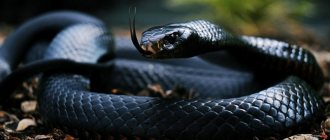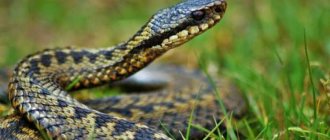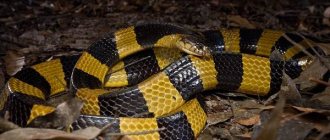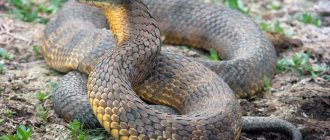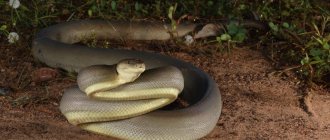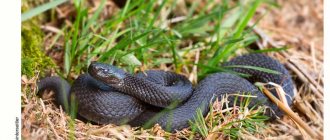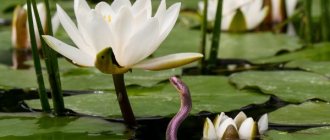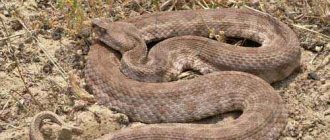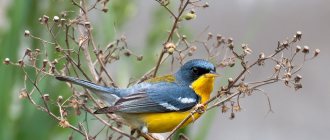Is the bite poisonous?
It is important to mention that just some time ago all poisonous snakes were called echidnas - in particular, even the black viper.
Look - Aquatic turtle: care and maintenance at home. Advice on selection and content (120 photos)
However, the black snake is the leader in the amount of venom released during a bite, and its venom has a powerful toxic effect.
The substance enters the blood and provokes protein coagulation. Before attacking, the snake extends its head 15 cm, rises and attacks the victim in one sharp movement.
Despite the fact that in some cases, deaths have been recorded after a black echidna bite, the venom is not as toxic to humans as it is to animals. That is why cases of instant death are extremely rare.
Nikolsky's viper in the Red Book
In recent years, the population of forest-steppe vipers has decreased. Although the species is not considered endangered, these reptiles require special attention and care.
Main causes of extinction
In Russia, Nikolsky's viper is a poorly studied species. These reptiles are continuously destroyed by the local population. Another reason for their extinction is the violation of natural habitats due to human economic activity. The forest-steppe species is also exterminated for the extraction of poison and further commercial sale.
Current population situation
According to the calculations of herpetologists, in 1996-2004, in the Khopra, Volga, and Medveditsa rivers, forest-steppe vipers were found in quantities of 1-5 individuals/ha.
In particularly humid areas, their numbers increased to 8–28 individuals/ha. Observations in recent years have shown that the number of these reptiles in Russia has decreased by 1.5-3.5 times compared to the beginning of the 90s.
Are protective measures required?
Nikolsky's viper is protected by law and is included in the Red Book of the Russian Federation. These reptiles are protected on the territory of the Khopersky Nature Reserve.
To preserve the population of these snakes in Russia, herpetologists plan to develop a special program for studying vipers and create the necessary conditions for preserving the species.
Snake with black spots on its head: what kind is it?
A snake with spots on its head may represent a common pit viper. Of course, the viper can be completely black or have any other shade.
The viper has a body reaching almost a meter in length. Male pit vipers are smaller and duller in color, while females are larger and can be black, brown, pink and even red.
There is a black zigzag line running down the viper’s back, and there may be an “X” shaped spot on its head. Sometimes the snake’s body is colored asymmetrically: one half may be light in color, and the other half dark. The line on the reptile's back may be yellow or orange.
In domestic latitudes, cases of viper attacks on people are often recorded. The bite of this creature causes severe pain and may include tissue swelling, necrosis, severe pain, headache, general malaise and weakness.
Of course, this bite is unlikely to be fatal, but in any case the victim should be immediately sent to a doctor.
Note!
- Domestic turtles - the most popular species, cultivation features, tips for care and maintenance (115 photos + video)
- Indian snakes: sacred, poisonous, most common and dangerous types of Indian snakes and their names (130 photos)
Small snakes - an overview of popular and rare species, habitats, food and names of snakes (115 photos)
Key Features
A peculiarity of all vipers is the presence of poisonous glands located in the sinuses behind the upper jaw.
The poison from them enters the bite site through two teeth that are empty inside. These teeth are attached to the rotating maxillary bone.
Usually these fangs are not visible, as they are folded and covered with a special film.
At the moment of attack, the reptile's jaw opens 180 degrees, and its fangs turn in the direction of the blow.
To photograph a snake bite, a photo of the viper must be taken at the moment of the attack. This is beyond the power of a person, but with the help of slow-motion filming on a video camera it is possible.
Due to the fact that the bite of this snake is very dangerous and can even lead to death, you need to know the following precautions:
- You should never touch a viper.
- In the forest where these snakes live, you must wear high, durable boots and thick trousers.
- Before entering thick grass or stepping into a hole, you need to make sure there are no reptiles there.
- When picking mushrooms or berries, you first need to rummage around the grass around you with a stick. The snake will crawl away or hiss.
- You should not move if a viper is crawling nearby. Most likely she will crawl past.
A peculiarity of all vipers is the presence of poisonous glands located in the sinuses behind the upper jaw. The poison from them enters the bite site through two teeth that are empty inside. These teeth are attached to the rotating maxillary bone
Another feature is the ability of the pupil to respond to light by changing its size.
This property is very rare for reptiles and is associated with a predominantly nocturnal lifestyle.
Interesting! Not every bite is accompanied by the release of poison; 25% of attacks occur “idly”. It is believed that the Egyptian Queen Cleopatra was killed by an African horned viper.
Like all reptiles, the viper loves warmth and light. During the day, she prefers to bask in the sun and remains relatively slow. However, at night, all her energy is directed towards obtaining food.
Snake: black snake with yellow head
It could be a dark snake with bright yellow spots on its head. Despite the fact that they are considered harmless creatures to humans, you need to be wary in any case.
Unlike vipers, snakes' pupils are round rather than rod-shaped. Snakes can be brown, brown or black in color.
Some snakes have variegated colors and the same bright spots: in this way they “imitate” poisonous snakes, therefore, in this case, coloring plays a protective function.
Water snakes often have a dark olive body color and a black spot on the back of the head. A distinctive feature of snakes is the unpleasant, pungent odor that they emit if the reptile is taken by surprise.
How does reproduction occur?
This snake is viviparous, it does not lay eggs, but gives birth to viable children. This distinguishes this species from its peers, since the eggs of other snakes develop in nests.
This reptile chooses a place well warmed by the sun to give birth to its offspring.
The body of newborn cubs is about 20 centimeters. At one time, the female gives birth to from 8 to 40 children. Already 10 days after birth, the cubs molt.
Photos of black snakes
Distribution and lifestyle
The Nikolsky viper is found in Russia and Ukraine, and its favorite habitat is wet river valleys.
She is much more comfortable there than in dry steppe conditions. It’s good if there is a lot of vegetation on the territory: most likely it is in them that you will find a predator.
There can be 2-5 vipers in one place at a time, although during the mating season the number often grows to 15-30 snakes. The peak activity of predators occurs in the warm season, while in the autumn-winter period they prefer to sleep in a secluded place.
The Nikolsky viper is an excellent swimmer, but on the surface of the earth it moves relatively slowly. When the slightest danger appears, it curls up into a ball and begins to hiss, sometimes rushing at the enemy. The activity of representatives of the species occurs more during the daytime, and each individual has its own territory, with an area of 3-7 hectares.
Also find out where the Russell's viper and the noisy viper are found and why they are dangerous.
Blue Racer Snake
An unusual scaly reptile with the same unusual name that man gave it. The species is on the verge of extinction.
It got its name from its characteristic pale blue body color, as well as its speed of movement. It has a rather aggressive disposition, and when meeting a person, it tries to bite. But he spends most of his time in hiding, trying not to be seen.
Like most reptiles, it eats insects, lizards, and happily destroys bird nests.
15
Coral adder / Micrurus
The multi-colored reptile has a distinctive pattern of red, black, yellow and orange rings. Color varieties depend on the species and habitat.
Distributed in North and Latin America, from Uruguay to the southern regions of the United States. They have deadly poison. After a bite, if an antidote is not administered and treatment is not provided, the person can die within 24 hours.
Handsome adders feed on small rodents, insects, and lizards. They can hunt amphibious forest inhabitants. In nature, there are several non-poisonous species that have adapted their color to their poisonous counterparts.
Garter snake / Thamnophis sirtalis
These small-sized snakes with different colors are also called garden snakes. They feel great both among the plains and high in the mountains.
They settled from Mexico to the northern regions of Canada. They lead a diurnal lifestyle and grow no more than 80 cm. Females are slightly larger than males. The only species of couchi gigas can reach a record height of 1.4 m.
They can be easily identified by the stripes along their entire body. In some species there are up to 8 such longitudinal stripes. They feed on tadpoles, frogs, and hunt salamanders and ground lizards. In total, more than 40 subspecies of garden snakes are distinguished in zoology.
7
Types of snakes
There are many different snakes, but the most common in our country are these three species.
The common snake (Natrix natrix) is found in Europe (except for the Far North). It is a black or dark gray snake measuring up to 1.5 m (usually 1 m, females are noticeably larger than males) with two yellow or bright orange spots on the sides of the head. The snake can be found in overgrown bushes near water, in damp forests and swamps. The common snake sometimes settles near people’s homes: in heaps of garbage in the yard, in sheds, stables, cellars and poultry yards. It often hangs onto chickens and ducks or crawls into stables and barnyards. The snake even lays eggs here that resemble those of a pigeon. A dinner egg is filled with a yolk inside, surrounded by a thin layer of white. The eggs are covered with a leathery shell. The female lays eggs bound into “beads” by a gelatinous substance. Oviposition can be found in dung heaps, in a heap of dry leaves, damp moss or in loose soil. There can be 15 - 17 eggs (less often up to 30 pieces). About three weeks pass, and the cubs are born. The length of a snake that has just hatched from an egg is about 15 cm. It is capable of eating worms, snails and various insects.
The common snake spends the winter on land: it hides in old burrows made by mammals, climbs under the roots of trees, etc.
The water snake (Natris tesselata) lives in the southern regions of Russia, as it is more heat-loving than the common snake. There are many such snakes in the Volga region and the Don. The water snake is often seen in Crimea (especially on the Kerch Peninsula). These snakes stay near water, not only fresh, but also salty. They swim well (even in big waves) and dive. They feed on frogs, tadpoles, small fish (gobies) and even shrimp. Less commonly, small mammals and birds. To make it easier for the snake to swallow the fish, the snake holds it in its mouth and swims to the shore. There it finds support for its body, sits comfortably near it, and then begins to swallow its prey. These snakes hide from the heat underwater. Snakes sleep in dry grass, in hay, climb into rodent holes, and under stones. In the morning, water snakes slowly crawl onto the banks of rivers and reservoirs. Snakes hibernate under rocks, in crevices and in dense bushes.
The tiger snake (Rhabdophis tigrina) in Russia is found in the south of the Far East (Primorsky Krai, near Khabarovsk) in wet areas near water, in forests and meadows. They are seen even in cities. The length of the snake is about 110 cm. It feeds on frogs, toads, small rodents and fish. This snake is considered conditionally venomous, as its poisonous teeth are located deep in the mouth (on the back of the maxillary bone).
For humans, tiger snake bites, usually inflicted by short front teeth, pass without a trace. However, in cases where the bite is inflicted by the enlarged posterior maxillary teeth lying deep in the mouth, and saliva and the secretion of the upper labial glands enter the wound in large quantities, severe poisoning can occur, not inferior in severity to that from the bite of real poisonous snakes (“Animal Life, Vol. 5).
Green mamba / Dendroaspis viridis
In tropical rainforests you can meet one of the most dangerous snakes in nature. But it’s better to bypass it. The fast-acting poison causes tissue necrosis and leads to paralysis.
The mamba has a graceful build. The body is bright yellow-green in color. There are individuals whose tail is completely yellow. The belly is white or with a light yellowish tint.
Leads a terrestrial and arboreal lifestyle. It hunts during the day, but can crawl out of its shelter at night. This is an agile and fast snake, capable of developing high speed when moving.
